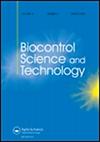小褐飞蛾对小褐飞蛾和黄褐飞蛾幼虫的寄主偏好及发育
IF 1.2
4区 农林科学
Q4 BIOTECHNOLOGY & APPLIED MICROBIOLOGY
引用次数: 0
摘要
摘要/ ABSTRACT摘要:哈氏小茧蜂(habrbrabon hebetesay,膜翅目:小茧蜂科)是一种幼虫外寄生性昆虫,主要以蛾类为主。杏仁蛾(Ephestia cautella Walker)和大枣蛾(Arenipses sabella Hampson)是枣树的两种经济蚜类害虫。虽然在野外经常发现被寄生的小蠊幼虫,但没有关于它们与寄生蜂相互作用的资料。假设sabella a . sabella作为H. hebetor宿主的适宜性,因此对其与E. cautella的适宜性进行了测试和比较,后者作为H. hebetor的重要宿主受到了广泛的研究关注。结果表明,拟寄生虫能在sabella A.幼虫上发育繁殖,与catella E.幼虫无显著差异。当两种寄主的幼虫同时供于雌性拟寄生蜂48 h时,每12 h检查一次,黄斑姬蜂的麻痹率(0.98)和寄生率(0.93)较高,且消耗的时间较少。这很可能是因为它的大小几乎是沙贝拉的一半。其较大的体型有利于寄生物在其上产卵。结果的不显著差异表明,寄生蜂并不偏爱其中一种寄主。本研究的结果为今后在这一有发展前景的领域进行更多的研究后,进一步了解白僵菌对小蠊的生物防治策略提供了有价值的见解。本文章由计算机程序翻译,如有差异,请以英文原文为准。
Host preference and development of Habrobracon hebetor on larvae of Arenipses sabella and Ephestia cautella
ABSTRACT Habrobracon hebetor Say (Hymenoptera: Braconidae) is an larval ectoparasitoid, mainly of pyralid moths. The almond moth, Ephestia cautella Walker and the greater date moth, Arenipses sabella Hampson are two economic pyralid pests of date palm that were found to be attacked by the parasitoid. Although parasitised larvae of A. sabella are often encountered in the field, no data were available regarding their interaction with the parasitoid. The suitability of A. sabella as a host of H. hebetor was assumed, so it was tested and compared to that of E. cautella, which has received much research attention as an important host of the parasitoid. The parasitoid proved to be able to develop and reproduce on A. sabella larvae, and no significant difference was detected with E. cautella larvae. When the larvae of the two hosts were offered simultaneously to female parasitoids for 48 h, the rates of paralysis (0.98) and parasitism (0.93) were higher on E. cautella and consumed less time when checked every 12 h. This is likely because it is almost half the size of A. sabella. The larger size of A. sabella larvae supported the parasitoid to deposit more eggs on it. The nonsignificant difference in the results suggests that the parasitoid does not prefer one of the hosts over the other. The results of this study provide valuable insights into the effectiveness of H. hebetor against A. sabella for use in biological control strategies for controlling this pest after conducting more research in this promising area.
求助全文
通过发布文献求助,成功后即可免费获取论文全文。
去求助
来源期刊
CiteScore
3.20
自引率
7.10%
发文量
64
审稿时长
4-8 weeks
期刊介绍:
Biocontrol Science and Technology presents original research and reviews in the fields of biological pest, disease and weed control. The journal covers the following areas:
Animal pest control by natural enemies
Biocontrol of plant diseases
Weed biocontrol
''Classical'' biocontrol
Augmentative releases of natural enemies
Quality control of beneficial organisms
Microbial pesticides
Properties of biocontrol agents, modes of actions and methods of application
Physiology and behaviour of biocontrol agents and their interaction with hosts
Pest and natural enemy dynamics, and simulation modelling
Genetic improvement of natural enemies including genetic manipulation
Natural enemy production, formulation, distribution and release methods
Environmental impact studies
Releases of selected and/or genetically manipulated organisms
Safety testing
The role of biocontrol methods in integrated crop protection
Conservation and enhancement of natural enemy populations
Effects of pesticides on biocontrol organisms
Biocontrol legislation and policy, registration and commercialization.

 求助内容:
求助内容: 应助结果提醒方式:
应助结果提醒方式:


